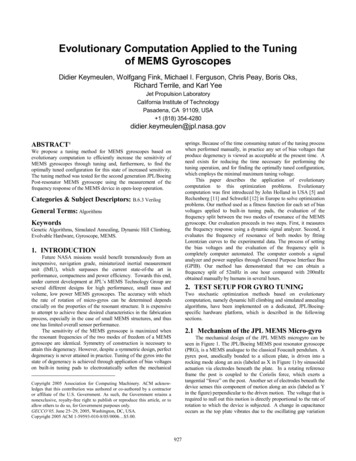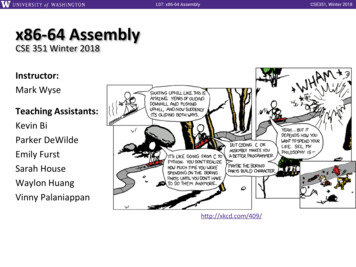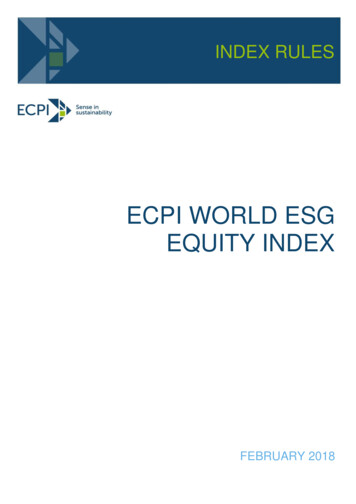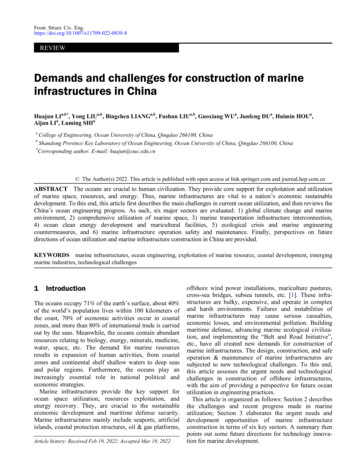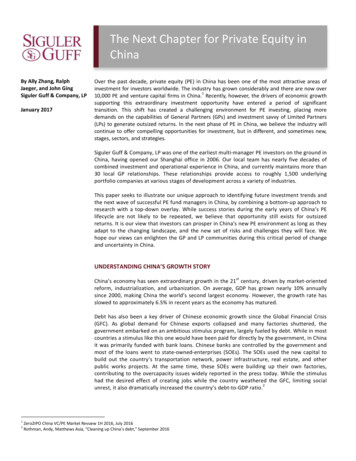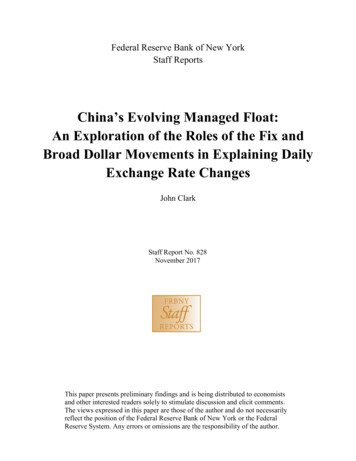
Transcription
Federal Reserve Bank of New YorkStaff ReportsChina’s Evolving Managed Float:An Exploration of the Roles of the Fix andBroad Dollar Movements in Explaining DailyExchange Rate ChangesJohn ClarkStaff Report No. 828November 2017This paper presents preliminary findings and is being distributed to economistsand other interested readers solely to stimulate discussion and elicit comments.The views expressed in this paper are those of the author and do not necessarilyreflect the position of the Federal Reserve Bank of New York or the FederalReserve System. Any errors or omissions are the responsibility of the author.
China’s Evolving Managed Float: An Exploration of the Roles of the Fix and Broad DollarMovements in Explaining Daily Exchange Rate ChangesJohn ClarkFederal Reserve Bank of New York Staff Reports, no.828November 2017JEL classification: F3, F31, F33, G15, O16AbstractWe investigate the drivers of daily changes in the exchange value of the Chinese currency (CNY)since early 2016, when a new regime was introduced for setting the fix—the midpoint of theCNY’s daily trading range against the U.S. dollar. Daily changes in the fix, which is announcedjust prior to the onset of onshore trading, are shown to be highly predictable and very responsiveto the change in the CNY/USD rate during the previous day’s onshore trading session and tochanges in dollar cross rates. While highly predictable, the fix is shown to have uneven predictivepower for the subsequent evolution of the currency’s exchange value. Daily changes in theclosing value of the exchange rate have centered on the changes implied by the fix to a muchgreater extent in months with higher intervention intensity, but less over the course of 2017, asintervention has waned. We document ways in which the short-run behavior of the CNY/USDexchange rate has evolved to more closely resemble behavior generally observed in freelyfloating currencies, even as the CNY continues to exhibit unusually low daily volatility. On daysof broad dollar strengthening, the CNY is found to depreciate against the dollar but appreciateagainst the CFETS index, the authorities’ main reference basket; the CNY now typicallyappreciates less than half as much as previously, when the currency was being managed primarilyagainst the dollar.Key words: Chinese currency, Chinese yuan, CNY, exchange rate regime, currency policy,flexible exchange rate, intervention, financial developmentClark: Federal Reserve Bank of New York (email: john.clark@ny.frb.org). This paper presentspreliminary findings and is being distributed to interested readers solely to stimulate discussionand elicit comments. The views expressed in this paper are those of the author and do notnecessarily reflect the position of the Federal Reserve Bank of New York or the Federal ReserveSystem.
I.Introduction and overviewMarket concerns about Chinese currency policy have declined substantially since roiling global marketsin August 2015 and early 2016, notwithstanding further notable depreciation of the Chinese yuan (CNY)over the course of 2016. Many market participants have traced the reduced unease in part to theauthorities’ shift to a more predictable framework for setting the daily fixing rate; the fixing rate servesas the mid-point of the currency’s daily trading range and is announced just prior to the start of theonshore trading session. But suggestions that the fix has played a key stabilizing role appearincomplete, given that they presume that the fix itself dampens volatility and guides where the CNYtrades subsequently.Surprisingly, the recent trading day behavior of the CNY has been little studied, notwithstanding clearsigns both of active management by the authorities, and an important role for market forces. We helpfill this gap by investigating the performance of the CNY since February 2016, focusing on the role of thedaily fix, dollar cross-rates, overnight trading in the offshore market, and intervention in influencing theevolution of the bilateral and multilateral exchange value of the currency.Regarding the fix, we show that about 95 percent of its daily variation can be predicted from a simpleempirical model using changes in an index of dollar cross rates (e.g. EUR/USD, JPY/USD, etc, withweights taken from the authorities’ main reference index), and changes in the CNY/USD exchange rateduring the previous official trading day. We also document several shifts over the past year in thedegree of passthrough of prior-day CNY/USD changes, including since mid-May 2017, when a so-called“countercyclical” element was introduced, and the passthrough declined notably. Our estimatedparameters suggest that, by design, the fix plays at best a modest role in stabilizing the CNY’s valueagainst the dollar and the authorities’ reference currency basket. This is because the fix passes throughmost, if not all, of the changes in the bilateral CNY/USD exchange rate during the prior trading day, andintroduces only partial offsets for the impact of changes in dollar cross rates on the currency’smultilateral value.We then turn to investigating the degree to which daily changes in the fix appear to guide changes in thevalue of the CNY during the ensuing trading day. We propose a specific measure of “centering” and findthat daily changes in the CNY closing price do not fully center on the changes implied by the fix, thoughthey do take directional cues. In contrast, we find that the daily change in the CNY close does fullycenter on the change between the previous day’s closing price and the onshore market’s open. We also1
find that the daily changes in the CNY center more closely around the fix during months with highintervention. Our results suggest that waning intervention over the course of 2017 may help explainwhy the fix has had much less predictive power in the latter part of our sample period.To shed light on the CNY’s incomplete centering on the fix, we explore the sensitivity of daily changes inthe closing prices of CNY/USD exchange rate to the variables that predict changes in the fix, as well as tocontemporaneous changes in dollar cross rates during official trading hours and overnight developmentsin the offshore CNH market. We find that daily changes in the CNY/USD closing price are generally muchless sensitive than the fix to the variables that explain changes in the fix, with the notable exception ofovernight changes in dollar cross rates. Of note, we find little evidence that the May 2017 introductionof a “countercyclical element” to the daily fix, apparently calibrated to lean against or partially reverseprior day CNY changes, has translated into similar changes in the behavior of the exchange rate. Wealso find that surprise deviations of the fix from our empirical model have limited predictive power forchanges in the CNY during the ensuing trading day. This latter result appears inconsistent with the viewoften expressed by market commentators that surprises in the fix provide important signals thatinfluence subsequent exchange rate changes.We find that the CNY now responds systematically to short-term broad dollar movements, an importantgoal of the new fixing regime. Our estimated coefficients suggest that, on days when the dollar broadlystrengthens, the currency now typically weakens against the dollar, but appreciates vis-à-vis theauthorities’ main reference basket (the CFETS index), though by less than half as much as when thecurrency was being managed bilaterally against the dollar.Our results also document several ways in which daily changes in the CNY have evolved to more closelyresemble the near random walk behavior typically seen in floating rate currencies. More recently, dailyCNY changes do not appear to be correlated with lagged changes in dollar cross rates or the CNY/USDrate; daily changes in the CNY persist over time; and official intervention diminished substantially overthe course of 2017. But the CNY’s daily volatility against the dollar remains unusually low, compared tothe currencies of most advanced economies and other large emerging market economies.We interpret our results as pointing more to the authorities’ active dampening of volatility in theexchange rate during the trading day, rather than the fix, as the key factor in calming markets since early2016. By avoiding sudden moves that could upset markets, the authorities found space to allow more2
substantial market-driven and/or policy-driven adjustment over longer horizons, both against the dollarand the authorities’ reference basket.II.Recent evolution of China’s currency regimeOver the past two years, China’s approach to exchange rate management has evolved significantly,moving from a de facto crawling peg against the dollar with gradually widening bands, to a managedfloat referencing a currency basket. Key steps in the recent evolution have not always been wellexplained. As a result, some developments triggered surges in global market volatility in mid-2015 andearly-2016, reflecting concerns about China’s outlook, and its potentially significant impact on globaltrade and output. However, communication has improved since February 2016, and market participantshave often cited the predictability of the post-February fix regime as a contributor to the reduction involatility in Chinese and global markets since early 2016.For context, between mid-2005 and mid-2015, the Chinese authorities alternated between periods ofgradual, but not entirely steady appreciation of the daily fixing rate against the US dollar, and periods ofholding the fixing rate relatively stable (Chart 1). Under this approach, the currency could at timespersistently trade near the strong or weak side of a gradually widening trading band, requiring thecentral bank to engage in large scale intervention to maintain the currency within the target range.On August 11, 2015, the Chinese authorities took a notable step toward making the currency regimemore flexible: they announced that going forward the daily fixing rate would be set with reference to3
the previous day’s closing level. In principle, the new rules implied that the CNY could depreciate asmuch as 10 percent against the dollar in a week. But in practice, the authorities intervened heavily inresponse to an upsurge in volatility and accelerating capital outflows following the August policy changeannouncement. As a result, after an initial adjustment, the exchange value of the CNY against the dollartraded in relatively narrow range from mid-August into October.Another important step was taken in December 2015, when the authorities announced and began toregularly publish a new official effective exchange rate index (the CFETS Index), which they said “shouldhelp bring about a shift” in how market participants viewed the exchange rate. The announcement wasgenerally interpreted by market participants as signaling the authorities’ intention to manage theexchange rate more actively against this new index going forward. 1 But the operational implicationswere not explained nor understood at the time. When the CNY subsequently began to depreciate at anaccelerating pace in December 2015 and early 2016, against a backdrop of broad dollar strength,Chinese and global market volatility spiked. Market participants feared that the Chinese authoritieswere countenancing or perhaps even pursuing a substantial weakening of the currency.In an effort to calm markets, the Chinese authorities again resorted to heavy intervention in January andearly February 2016 to stabilize the dollar-yuan exchange rate. In addition, they took steps, mostnotably in mid-February 2016, to explain more fully how they expected the new exchange rate regime tofunction, and to reassure local and foreign investors that they were neither targeting, nor expectingfurther substantial depreciation. Subsequently, the authorities provided detailed guidance to marketparticipants regarding how the fixing rate should evolve in relation to developments in the CNY/USDexchange rate and dollar cross-rates during the prior trading day and overnight, enhancing thepredictability of the process. As it became clear that the new approach to setting the fix was beingimplemented in line with the authorities’ guidance, market participants began to cite the predictableapproach as an important stabilizing factor in Chinese and global markets.1It had already been announced, on August 11, 2015, when the new fixing regime was introduced, that the fixingrates would also “take into account” exchange rate movements among the major currencies. However, beforeDecember 2015, it was not clear that any material adjustments for cross rate developments were in fact beingmade. Of note, over the previous decade, the authorities had characterized the de facto crawling peg regime as a“managed floating exchange rate based on market supply and demand with reference to a basket of currencies,”though the basket was never specified and there was no significant relationship between short-term cross-ratemovements and changes in the dollar exchange rate.4
III.The mechanics and role of the daily USD/CNY fixUnder current practices, China’s official foreign currency trading day begins at 9:30 am CST (ChinaStandard Time), and ends at 4:30 pm CST (see Chart 2). Just prior to the launch of trading, at 9:15 CST,the PBOC announces the fixing rate for the USD/CNY exchange rate, based on submissions from localdealing banks. The authorities also announce fixing rates against the CNY for other currencies includedin the CFETS index, based on the USD/CNY fix and the prevailing dollar crosses. The USD/CNY fixing rateis based on a trimmed weighted average of submissions by market participants.The fixing rate, officially referred to as the “central parity rate”, serves as the midpoint point for theintraday trading range ( 2 percent) for the currency, but is not a mandated transaction rate for entitiesbuying or selling FX. In this respect, the CNY fix differs from the transaction-based fixes observed insome other markets, most notably the WM/Reuters benchmark rates set each day in London at 4pm. Infact, when onshore CNY trading opens at 9:30 CST, trading often begins at prices that differ from thefixing rate. Indeed, over the past year, the standard deviation of the log difference between the fix andthe open price has been nearly half as large as the standard deviation for changes in the dollar value ofthe CNY over the full day (i.e. from close to close).PBOC officials have provided guidance to fixing participants (dealing banks in the onshore FX market)regarding how to formulate their submissions. Initially, in early 2016, they counselled participants thattheir submissions should take account of both (a) market forces during the prior trading day, asreflected in the official 4:30 pm CST closing price vis-à-vis the dollar, which are expected to be passedthrough in full, and (b) the amount of currency change against the dollar needed to dampen the changein the value of the CFETS index due to cross-rate development during the previous trading day andovernight (i.e. after the official close) (PBOC 2016). The guidance also suggested that participants5
consider changes in other reference indices (such as the SDR basket and the BIS’ effective exchange rateindex), but didn’t suggest specific weights.Of note, while the onshore market officially closes at 4:30 pm CST, the onshore trading system remainsopen until 11:30 pm CST. However, onshore liquidity declines markedly after the official close and theauthorities have instructed market participants to only take into account onshore developments up tothe official close of the prior day in setting their submissions for a given day’s fix.The authorities announced a modification to their guidance about one year later, over the weekend ofFebruary 18-19, 2017, counseling fix participants to only seek to offset cross-rate developments (i.e.between the dollar and other currencies, excluding the CNY), that take place overnight, between theofficial close of the previous trading day and 7:30 am CST. Most recently, on May 26, the authoritiesindicated publicly that they were “considering” changing the fixing mechanism yet again, to include anundefined “countercyclical mechanism”. The addition of a countercyclical mechanism was confirmed inthe PBOC’s Q2 2017 Monetary Policy Report (PBOC 2017). Many market participants perceive that theintroduction of countercyclical adjustments may have slightly preceded the May 26 announcement,based on the behavior of the fix earlier in the month (Peng and Wang, 2017). While the countercyclicalmechanism has not been explicitly explained, the general view among market commentators has beenthat it has entailed both increased discretion and a systematic effort to lean against changes in theCNY/USD exchange rate during the prior trading day.IV.The CFETS Index and the “CFETS-weighted Dollar-Cross Index”The authorities’ main reference index, the CFETS index, was first announced in December 2015. It is ageometrically weighted index of the foreign currency cost of the CNY. Initially, 13 currencies wereincluded in the index, comprised of all the currencies included in the CFETS automated system at thattime; the basket was expanded to 24 currencies at the end of 2016, incorporating additional currenciesthat had been added to the CFETS system over the course of 2016.As shown algebraically in Annex 1, the CFETS index equivalently can be calculated as the product of theUSD cost of the CNY ), relative to the base period, and a weighted dollar-cross index(DolCross) of the cost of the dollar in the other currencies in the CFETS basket (using the CFETS indexweights). Representing the CFETS as the product of the bilateral CNY/USD rate and CFETS-weighteddollar-cross index is useful for examining the contribution of these two factors to changes in the nominal6
effective exchange rate, as measured by the CFETS index. Putting things in terms of log changes wehave that over any window: ln(𝐶𝐶𝐶𝐶𝐶𝐶𝐶𝐶𝐶𝐶) �𝐷𝐷𝐷𝐷) �)This equation implies that to keep the CFETS index unchanged over any window, the CNY would need todepreciate against the dollar by the same magnitude that the dollar appreciates against the weighteddollar-cross index, and vice versa. 2V.An empirical model of the CNY fixThe Chinese authorities’ published guidance on how the daily fix is set makes reference to incorporatingchanges in CNY/USD rate during the preceding trading day, and setting the fix to offset changes in thedollar cross rates that would change the level of the CFETS index. Accordingly, in our empirical model,we regress the daily log change in the fix (from fix-to-fix) on the daily log change in the CFETS-weighteddollar-cross index (from fix-to-fix), and the daily log change in the CNY/USD exchange rate (from closeto-close). In both cases we distinguish between the “overnight” period, changes from one day’s officialclose to the next day’s fix, and the “onshore trading day” period, from the fix to that day’s �𝐹)𝑡𝑡ln 𝑡𝑡 ���𝐷𝐷𝐷(𝐹𝐹𝐹𝐹𝐹𝐹)𝑡𝑡 𝐶𝐶 𝛽𝛽1 𝑙𝑙𝑙𝑙 ��𝑐𝑐𝑐(𝐶𝐶𝐶𝐶𝐶𝐶)𝑡𝑡 ���𝐷𝐷𝐷(𝐶𝐶𝐶𝐶𝐶𝐶) 𝛽𝛽2 𝑙𝑙𝑙𝑙 ��𝐷𝐷𝐷(𝐹𝐹𝐹𝐹𝐹𝐹)𝑡𝑡 1 𝑡𝑡 ) 𝛽𝛽3 𝑙𝑙𝑙𝑙 𝑡𝑡 1 𝛽𝛽4 ln 𝑐𝑐𝑐𝑐𝑐𝑐(𝐶𝐶𝐶𝐶𝐶𝐶) 𝑡𝑡 1 𝜀𝜀𝑡𝑡𝑡𝑡 1𝑡𝑡 2(1)where 𝑡𝑡 is the fixing price of the Chinese yuan (CNY) in US dollars on trading day t, 𝑡𝑡 isthe 4:30 closing price of the CNY in US dollars on trading day t, and ��𝐷𝐷𝐷(𝐹𝐹𝐹𝐹𝐹𝐹)𝑡𝑡 � are the values of the CFETS-weighted dollar-cross indexes measured using dollarcrosses at the fix (9:15 am CST) and close (4:30 pm CST) respectively, on trading day t. 3 For2The weights in the CFETS-weighted dollar-cross index do not sum to one. This reflects the fact that CFETS weightssum to one, but the dollar is not included in the dollar-cross index. An implication is that the CFETS-weighteddollar cross index, by construction, will have less volatility than an index where the weights for the included seriesare scaled up to sum to one. For example, if all the dollar crosses were to rise by an equivalent x percent, theCFETS-weighted dollar-cross index would rise by the product of the aggregate weights (i.e. one minus the dollar’sweight in the CFETS basket) and x percent.3Note that we get almost identical results if instead we place the fix-vs-prior close differential on the left handside. Subtracting 𝑙𝑙𝑙𝑙 𝑡𝑡 )𝑡𝑡 1 from both sides of equation (1), and rearranging we get:7
��𝐷𝐷𝐷(𝐹𝐹𝐹𝐹𝐹𝐹)𝑡𝑡 , we use the cross rates implied by the official fixing rates of the CNY against the variouscurrencies. We use the Chinese trading calendar, and measure changes in dollar crosses across anyChinese market holidays.Our estimates use data for the period from February 17, 2016 through September 28, 2017. Thiswindow begins when a new approach to setting the fix apparently began to be implemented, comingout of the Chinese New Year Holiday of 2016; we eliminate the first two trading days after that holidaybecause of a large initial currency adjustment following the extended holiday. Details about our datacan be found in Annex 2.We identify three apparent adjustments to the fixing rule over the course of our sample window. Ourestimated coefficients appear to shift in the period following the November 8, 2016 US election, whenthe US dollar appreciated rapidly, and the Chinese authorities stepped up the pace of intervention andtightened controls on capital outflows in an effort to lean against a weakening of the CNY. A secondshift appears to have taken place starting February 20, 2017, following the issuance of new guidance tofix participants over the weekend of February 18-19; Chinese banks were instructed from that pointforward to only adjust for overnight changes in dollar crosses, and no longer include adjustments forchanges in the dollar crosses during the prior trading day. And we identify a third breakpoint in midMay 2017, when the authorities publicly floated the possibility of adding an undefined countercyclicalelement to the daily fix; we chose May 15 as our break date after investigating windows between endApril and end-May for a possible regime break. Chow F-tests for structural breaks at each of these threedates were able to reject the null hypothesis of no breaks at the 1 percent level.The evolution of the CNY/USD rate, the CFETS index, and the CFETS-weighted dollar cross index sinceend-2015 is summarized in Chart 3. Chart 3 also contains vertical lines showing the beginning and endof our sample and the three break points which we identify; we label the implied time periods I throughIV. As can be seen, in the latter two periods, III and IV, the dollar-cross index trended downward ���)𝑡𝑡ln 𝑡𝑡 ���𝐷𝐷𝐷(𝐹𝐹𝐹𝐹𝐹𝐹)𝑡𝑡 𝐶𝐶 𝛽𝛽1 𝑙𝑙𝑙𝑙 ��𝐷𝐷𝐷(𝐶𝐶𝐶𝐶𝐶𝐶)𝑡𝑡 ���𝐷𝐷𝐷(𝐶𝐶𝐶𝐶𝐶𝐶) 𝛽𝛽2 𝑙𝑙𝑙𝑙 ��𝐷𝐷𝐷(𝐹𝐹𝐹𝐹𝐹𝐹)𝑡𝑡 1 𝑡𝑡 ) (𝛽𝛽3 1) 𝑙𝑙𝑙𝑙 𝑡𝑡 1 𝛽𝛽4 ln 𝑐𝑐𝑐𝑐𝑐𝑐(𝐶𝐶𝐶𝐶𝐶𝐶) 𝑡𝑡 1 𝜀𝜀𝑡𝑡𝑡𝑡 1𝑡𝑡 2(1a)The estimated coefficients, standard errors, and residuals are identical to those in (1), except the coefficient on𝑙𝑙𝑙𝑙 𝑡𝑡 )𝑡𝑡 1 , which becomes (𝛽𝛽3 1).8
the course of 2017, and fully reversed the increase which took place during Q4 2016. Overall, the CNYdepreciated by 6½ percent against the CFETS index between end-2015 and end-September 2017, withabout 2 percentage points of the decline due to depreciation of the CNY against the dollar and 4½percentage points due to depreciation of the US dollar against the CFETS-weighted dollar-cross index.Chart 4 summarizes our estimation results for our empirical model of the daily fix. In each panel weshow our estimated response coefficient for a given explanatory variable, and a 2 standard deviationconfidence interval around the coefficient estimate. The first dot in each panel shows the estimatedresponse coefficient for the full sample period, while subsequent dots show our estimated coefficientsfor each of the four subsamples, labeled I through IV.Looking first to panel A, it can be seen that the estimated response coefficient to overnight changes inthe CFETS-weighted dollar crosses (i.e. from the prior close to the fix) is fairly stable across our four subsamples, at around -0.6. 4 This coefficient implies that when the dollar-cross index rises (i.e. the dollarstrengthens) by 10 basis points overnight, the fix will be set 6 basis points weaker (the CNY depreciatesvis-à-vis the dollar), and vice versa when the dollar index declines. While the coefficient on the dollarcrosses is sizeable, it is also significantly different from -1, which is the value that would imply full offsetof the impact of dollar cross changes on level of the CFETS index. In other words, the fixing rule wouldonly partially stabilize the value of the CNY against the CFETS index in the face of cumulative overnightchanges in the dollar cross indices.4Jermann, Wei, and Yue (2017) find a response coefficient to dollar cross movements of around -0.5. Theyhypothesize that this value reflects an equal weighting on two perceived objectives of the Chinese authorities: toadjust the fix to reflect supply and demand conditions and to stabilize the currency against the reference basket.9
Panel B shows our estimated response coefficients to changes in the dollar-cross index during theprevious trading day (from the prior fix to the prior close). These coefficients evolve in a mannerbroadly consistent with changing PBOC public guidance: from February 2016 through February 2017(sub-periods I and II), we find estimated response coefficients that are essentially that same as those onthe overnight dollar crosses, -0.6. But after February 18, 2017, when the PBOC instructed banks to onlyconsider overnight changes in cross rates, the estimated coefficient becomes statisticallyindistinguishable from zero in period III. In the most recent period, from mid-May into September,when unspecified countercyclical adjustments were introduced to banks’ fix submissions, we findevidence of a renewed offset adjustment for dollar cross-rate movements in the prior trading day, but ofsmaller magnitude than in periods I and II.Panel C plots the estimated response of the fix to the log difference between the prior day’s closingprice of the CNY/USD rate and the fix that preceded it. The PBOC’s public guidance implies that thiscoefficient should be 1, implying full pass-through of the previous trading day’s change vis-à-vis thatday’s fix. For our full sample period, we find a response coefficient close to, but below 1, equal to about10
seven-eighths. This coefficient implies that almost all of a given trading day’s change in the level of theCNY/USD rate vis-à-vis the previous day’s fix is carried through to the next day’s fix.Of note, the estimated pass-through coefficient is statistically indistinguishable from 1 in the first andthird subsample periods. However, in the second and fourth subsamples, the pass-through declines toabout 0.8 and 0.7, respectively. The lower pass-through from November to February may have reflectedan effort to dampen currency volatility in the window following the US election, when the dollar wasstrengthening broadly, and the CNY tending to depreciate. And the more recent lowering of the passthrough, since May 15, 2017, likely reflects the impact of the discretionary “countercyclical element”that was added to the fixing rule around that time.Panel D plots the response of the fix to the prior day’s deviation of the fix from the previous close. Thiselement does not feature in the official guidance, but for the sample period as a whole, and several ofthe sub-periods, we find a statistically significant response coefficient of around 0.1. This indicates thatin practice there is some small positive serial correlation between changes between the close and thesubsequent fixes on successive days.Regarding the goodness of fit, as shown in panel F, we find very high R2s for our first three sub-periods:our simple model accounts for about 95 percent of the daily variation in the fix in each of these periods.In the last sub-period, since mid-May 2017, the explanatory power of our model of the fix declines to astill high 92 percent, suggesting a greater role for discretion and/or that we have not fully captured thecontours of the rumored “counter-cyclical element” in the current fixing rule. It is notable however thatwe do not find evidence of parameter instability within the window May 15 to September 28, 2017. Forthe sample as a whole, when we allow the coefficient on the previous day’s dollar crosses to differbefore and after February 18, 2017, in accordance with the published guidance, our R2 exceeds 94percent.It is important to recognize that while we have shown that the fix became very predictable (giveninformation about the prior trading session and overnight cross rates), our estimated coefficients implythat this post-February 2016 approach to setting the fix would by itself do little to dampen volatility inthe currency. This is because the fixing rule is calibrated to pass through most to all of the previousday’s changes in the CNY’s dollar value. Hence, large trading day changes lead immediately to largechanges in the subsequent fix. And as we have shown, while the fix did introduce some offsets for dollarcross changes, these were only partial (60 percent for overnight changes), and therefore sufficient to11
only dampen, but not prevent multilateral appreciation if the dollar strengthened broadly and on asustained basis. Indeed, the CNY depreciated significantly against both the dollar and the CFETS indexover the course of 2016, as shown in Chart 3. Moreov
Reserve System. Any errors or omissions are the responsibility of the author. Federal Reserve Bank of New York Staff Reports China's Evolving Managed Float: An Exploration of the Roles of the Fix and Broad Dollar Movements in Explaining Daily Exchange Rate Changes John Clark Staff Report No. 828 November 2017
